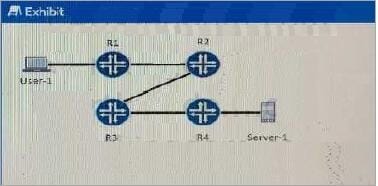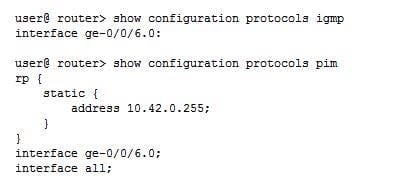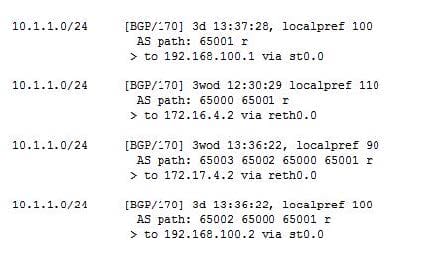Exam Details
Exam Code
:JN0-643Exam Name
:Enterprise Routing and Switching, Professional (JNCIP-ENT)Certification
:Juniper CertificationsVendor
:JuniperTotal Questions
:287 Q&AsLast Updated
:Mar 24, 2025
Juniper Juniper Certifications JN0-643 Questions & Answers
-
Question 41:
Referring to the exhibit, traffic is being sent from user1 to server 1 .The traffic is being classified using IP presentence into the default forwarding class expedited forwarding on R1 R2 and R4 .however R3 has no class service configuration. What are two potential actions R3 will take on the traffic? (Choose two)

A. the traffic is serviced by the best effort queue
B. the traffic is serviced by the assured forwarding queue
C. the traffic is serviced by the network control queue
D. the traffic is serviced by the expedited forwarding queues
-
Question 42:
What must you add to the configuration to allow a receiver connected to interface ge 0/0/6 to subscribe to group 232.0.0.1 from source 172.16.7.1?

A. Add sparse mode to PIM interface ge 0/0/6
B. Add version 2 to the state RP configuration
C. Add version 3 to IGMP interface ge 0/0/6
D. Add version 2 to IGMP interface ge 0/0/6
-
Question 43:
What must you use to facilitate this communication?
A. multiarea link
B. A multiarea adjacency
C. virtual link
D. A virtual private network
-
Question 44:
What is the purpose of realms in OSPFv3?
A. They pass IPv6 routes through IPv4
B. They pass IPv6 routes through VPNs
C. They pass IPv4 routes through IPv6
D. They pass VPN through IPv6
-
Question 45:
You are asked to configure OSPF for IPV4 and IPV6 route advertisement.Which two configuration accomplish the task? (Choose two)
A. [edit] user@switchl#show protocols ospf3{ export redistribute-ipv4; area 0.0.0.0 { interface al; } } [edit] user@switchl#show policy-options policy-statement redistribute-ipv4{ from family inet; to family inet6; then accept; }
B. [edit] protocols { ospf{ area 0.0.0.0 { interface all; } } ospf3 { area 0.0.0.0{
C. [edit] user@switch # show protocols Nospf { export redistribute-ipv6; area 0.0.0.0{ interface all; } } [edit] user@switch# show policy-options policy-statement redistribute-ipv6{ from family inet6; to family inet; then accept }
D. [edit] user@switch# show protocols ospf3 { relam ipv4-unicast { area 0.0.0.0 { interface all: } } area 0.0.0.0 interface all;
-
Question 46:
Each user in the office has a desktop computer and an IP telephone that share the same physical port that connects to the access switch. To provide security in the office 802 lx authentication has been turned on. Which two port access modes should be configured to allow both the desktop computer and IP telephone to connect through the network?
A. single supplicant mode
B. single secure supplicant mode
C. multiple supplicant mode
D. volP-compatibility supplicant mode
-
Question 47:
Your device receives the route 10.1.10/24 from all four of the destinations shown in the exhibit. In this scenario, which route would be active in the routing table?

A. the route from 192.168.100.1
B. the route from 172.16.4.2
C. the route from 172.17.4.2
D. the route from 192.168.100.2
-
Question 48:
You are creating a class of service, policy for your enterprise network. You want to ensure that the traffic classes have consistent classification and DSCP markings. In this scenario, which three actions would you perform to accomplish this task? (Choose three)
A. choose a behavior aggregate classifier matching the correct DSCP values on all core facing interfaces
B. configure a multifield classifier matching on IP address and protocol the maps incoming traffic to specific forwarding classes on ingress port of the access device
C. configure a rewrite rule on the access device to mark all traffic towards the core to have the correct DSCP markings
D. choose a behavior aggregate classifier matching on IP address and protocol the maps incoming traffic to specific forwarding classes on ingress ports of the access devices configure a rewrite rule on the access device to mark all traffic towards the end points to have the correct DSCP markings
-
Question 49:
Which two statements about this scenario are correct? (choose two)
A. the device is aware of all sources for the group
B. the device is receiving the multicast stream using the shortest path free
C. the forwarding path to the multicast source is through the RP
D. the source of the group is unknown
-
Question 50:
Which two statements are true?
A. The local router initiated the BGP session for the 192 168 1 peer.
B. The 192 168 2 1 peer initiated the BGP session with the local router.
C. The 192 168 6 1 peer initiated the BGP session with the local router.
D. The local router initiated the BGP session for the 192 168 2 1 pegP.
Related Exams:
JN0-102
Internet Associate, Junos(JNCIA-Junos)JN0-104
Junos, Associate (JNCIA-Junos)JN0-105
Junos, Associate (JNCIA-Junos)JN0-1101
Juniper Networks Certified Design Associate (JNCDA)JN0-130
Juniper networks Certified internet specialist.e(jncis-e)JN0-1301
Data Center Design, Specialist (JNCDS-DC)JN0-1302
Data Center Design Specialist (JNCDS-DC)JN0-1331
Security Design, Specialist (JNCDS-SEC)JN0-1332
Security Design, Specialist (JNCDS-SEC)JN0-1361
Service Provider Design Specialist (JNCDS-SP)
Tips on How to Prepare for the Exams
Nowadays, the certification exams become more and more important and required by more and more enterprises when applying for a job. But how to prepare for the exam effectively? How to prepare for the exam in a short time with less efforts? How to get a ideal result and how to find the most reliable resources? Here on Vcedump.com, you will find all the answers. Vcedump.com provide not only Juniper exam questions, answers and explanations but also complete assistance on your exam preparation and certification application. If you are confused on your JN0-643 exam preparations and Juniper certification application, do not hesitate to visit our Vcedump.com to find your solutions here.